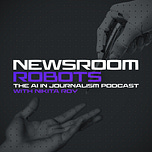The Pulitzer Prizes have long set the standard for journalistic excellence. So when two Pulitzer-winning teams revealed they had used AI in their work last year, it sent a clear message: artificial intelligence isn’t just coming to journalism—it’s already producing award-winning work.
City Bureau and the Invisible Institute won the Pulitzer Prize for Local Reporting for their Missing in Chicago investigation, which incorporated AI-assisted analysis. Meanwhile, The New York Times’ Visual Investigations team, which won the Pulitzer for International Reporting, also disclosed using AI in its work.
In total, five of the 45 Pulitzer finalists acknowledged incorporating AI in their submissions.
As Nieman Lab reported, the Pulitzer Board’s approach to AI was shaped by input from academic experts, newsroom leaders, and technology specialists, including an informational video produced by Newsroom Robots on AI’s potential in journalism.
To understand this pivotal shift in journalism, I sat down with Neil Brown, president of The Poynter Institute and former co-chair of the Pulitzer Prize Board.
Here are three key takeaways from our conversation:
1️⃣ AI Disclosure is About Building Trust, Not Judgment
The Pulitzer Board’s decision to require AI disclosure wasn’t about disqualifying AI in journalism—it was about ensuring transparency. Journalism depends on public trust, and clearly disclosing AI usage helps the audience understand how stories are produced. By being open about AI’s role, newsrooms can reinforce their credibility rather than undermine it.
2️⃣ The Hybrid Newsroom is Coming
Neil envisions a future where the traditional divide between editorial and tech teams disappears. He advocates for what he calls a "comfortable blend" of technologists and journalists in today's newsrooms.
"Technologists need to know a fair bit about journalism, and journalists need to know a fair bit about technology," he explains. Rather than keeping these teams separate, he stresses the importance of mutual understanding and collaboration.
3️⃣ The Real Risk
Beyond the immediate questions of AI implementation lies a deeper challenge: the audience is already finding new ways to consume information. As Neil reminds us, the biggest threat isn't AI—it's failing to evolve while the audience moves on.
The solution? Involve the audience in the development process now, making them partners in journalism's evolution rather than just consumers of it.
The Pulitzer-winning stories of 2024 have shown what's possible when newsrooms embrace new tools while staying true to journalism's core mission. As Neil puts it, success lies in "imagination and possibilities"—not in resistance or fear.
🎧 Listen to our full conversation available now on Apple, Spotify and other major podcast platforms.










